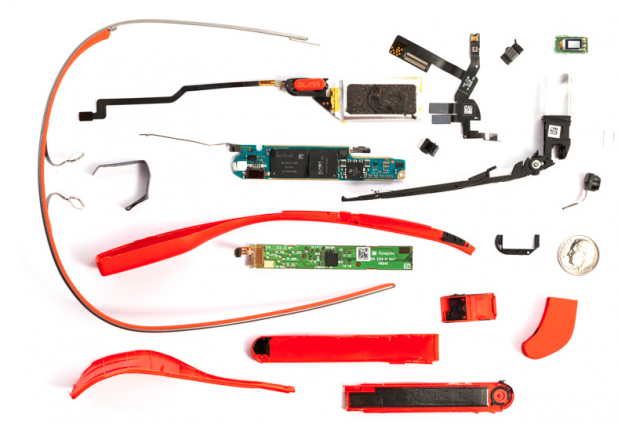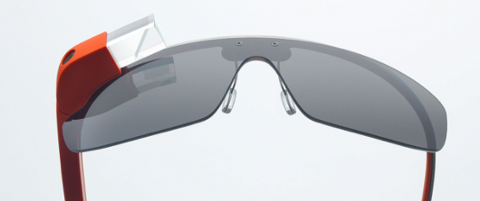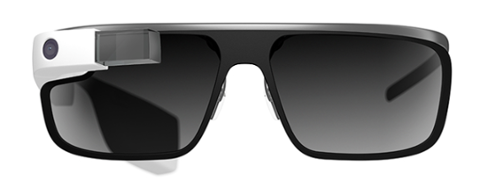 Google Glass, in pieces.[/caption] Ever wonder what’s inside Google Glass, the search-engine giant’s augmented-reality eyewear? Scott Torborg (co-founder of Crowd Supply) and Star Simpson (maker of many projects) did, and decided to act on that desire by breaking down a unit. The duo (assisted by at least four others) detailed their Google Glass teardown on Catwig.com. After obtaining a unit from the “Glass Studio” on Google’s Mountain View campus, they headed back to the lab and set to work. The first step: removing the Torx T5 screw that holds the “bulge” or “pod” to the Google Glass frame. Once the pod was free, prying off its plastic casing revealed a proximity sensor and “what appears to be an ambient light sensor,” the dissectors wrote in their notes. A few more minutes’ worth of unscrewing and cutting, and they gained access to the touchpad module (users tap or swipe the outside of the pod to interact with the Google Glass screen built into the device’s right lens) and the main CPU board. “This board was stuck to a thermal pad with lots of paste,” they wrote. “After removing it and cleaning off the pink thermal compound, we revealed the core chips powering Glass: a TI OMAP4430, 16GB of SanDisk flash, and an Elpida mobile DRAM chip. A flex PCB and an RF cable, anchored with some metal tabs and an MMCX (?) connector, trailed from this board to the behind-the-ear pod.” They kept working, eventually finding the single-cell 2.1-Wh (570-mAh) Lithium Polymer battery tucked into “a rounded bit” behind the wearer’s ear. In that same general area, they uncovered the bone conduction speaker. The dissectors also peeled away the camera (“typical smartphone-level size and format”) and the in-lens display (“with a native resolution of 640x360, the pixels are roughly 1/8th the physical width of those on the iPhone 5’s retina display”). Lots more about the hardware—including several nifty photos—are available on the Website. Torborg and Simpson didn’t delve into the Google Glass specs, but those are widely available. The hardware features 12GB of usable memory, synced with Google’s cloud storage (actual onboard storage is 16GB); the camera is capable of snapping 5-megapixel photos and 720p video. Google Glass is compatible with any Bluetooth-capable phone, and its MyGlass app—which enables SMS messaging and GPS—requires a companion device running Android 4.0.3 (the “Ice Cream Sandwich” build) or higher. Google has claimed the battery will provide a “full day of typical use,” although it warned in the specs sheet that certain functions—most notably video recording and Hangouts—could drain the battery faster. Google has poured considerable effort into demonstrating that Google Glass can be a viable product. But the technology also raises some thorny questions about surveillance culture, and whether people really want whole crowds recording every moment of our collective lives. Image: Catwig.com/work is licensed under Creative Commons BY NC SA 3.0
Google Glass, in pieces.[/caption] Ever wonder what’s inside Google Glass, the search-engine giant’s augmented-reality eyewear? Scott Torborg (co-founder of Crowd Supply) and Star Simpson (maker of many projects) did, and decided to act on that desire by breaking down a unit. The duo (assisted by at least four others) detailed their Google Glass teardown on Catwig.com. After obtaining a unit from the “Glass Studio” on Google’s Mountain View campus, they headed back to the lab and set to work. The first step: removing the Torx T5 screw that holds the “bulge” or “pod” to the Google Glass frame. Once the pod was free, prying off its plastic casing revealed a proximity sensor and “what appears to be an ambient light sensor,” the dissectors wrote in their notes. A few more minutes’ worth of unscrewing and cutting, and they gained access to the touchpad module (users tap or swipe the outside of the pod to interact with the Google Glass screen built into the device’s right lens) and the main CPU board. “This board was stuck to a thermal pad with lots of paste,” they wrote. “After removing it and cleaning off the pink thermal compound, we revealed the core chips powering Glass: a TI OMAP4430, 16GB of SanDisk flash, and an Elpida mobile DRAM chip. A flex PCB and an RF cable, anchored with some metal tabs and an MMCX (?) connector, trailed from this board to the behind-the-ear pod.” They kept working, eventually finding the single-cell 2.1-Wh (570-mAh) Lithium Polymer battery tucked into “a rounded bit” behind the wearer’s ear. In that same general area, they uncovered the bone conduction speaker. The dissectors also peeled away the camera (“typical smartphone-level size and format”) and the in-lens display (“with a native resolution of 640x360, the pixels are roughly 1/8th the physical width of those on the iPhone 5’s retina display”). Lots more about the hardware—including several nifty photos—are available on the Website. Torborg and Simpson didn’t delve into the Google Glass specs, but those are widely available. The hardware features 12GB of usable memory, synced with Google’s cloud storage (actual onboard storage is 16GB); the camera is capable of snapping 5-megapixel photos and 720p video. Google Glass is compatible with any Bluetooth-capable phone, and its MyGlass app—which enables SMS messaging and GPS—requires a companion device running Android 4.0.3 (the “Ice Cream Sandwich” build) or higher. Google has claimed the battery will provide a “full day of typical use,” although it warned in the specs sheet that certain functions—most notably video recording and Hangouts—could drain the battery faster. Google has poured considerable effort into demonstrating that Google Glass can be a viable product. But the technology also raises some thorny questions about surveillance culture, and whether people really want whole crowds recording every moment of our collective lives. Image: Catwig.com/work is licensed under Creative Commons BY NC SA 3.0 Google Glass Teardown Reveals Core Chips, More
[caption id="attachment_10346" align="aligncenter" width="618"]  Google Glass, in pieces.[/caption] Ever wonder what’s inside Google Glass, the search-engine giant’s augmented-reality eyewear? Scott Torborg (co-founder of Crowd Supply) and Star Simpson (maker of many projects) did, and decided to act on that desire by breaking down a unit. The duo (assisted by at least four others) detailed their Google Glass teardown on Catwig.com. After obtaining a unit from the “Glass Studio” on Google’s Mountain View campus, they headed back to the lab and set to work. The first step: removing the Torx T5 screw that holds the “bulge” or “pod” to the Google Glass frame. Once the pod was free, prying off its plastic casing revealed a proximity sensor and “what appears to be an ambient light sensor,” the dissectors wrote in their notes. A few more minutes’ worth of unscrewing and cutting, and they gained access to the touchpad module (users tap or swipe the outside of the pod to interact with the Google Glass screen built into the device’s right lens) and the main CPU board. “This board was stuck to a thermal pad with lots of paste,” they wrote. “After removing it and cleaning off the pink thermal compound, we revealed the core chips powering Glass: a TI OMAP4430, 16GB of SanDisk flash, and an Elpida mobile DRAM chip. A flex PCB and an RF cable, anchored with some metal tabs and an MMCX (?) connector, trailed from this board to the behind-the-ear pod.” They kept working, eventually finding the single-cell 2.1-Wh (570-mAh) Lithium Polymer battery tucked into “a rounded bit” behind the wearer’s ear. In that same general area, they uncovered the bone conduction speaker. The dissectors also peeled away the camera (“typical smartphone-level size and format”) and the in-lens display (“with a native resolution of 640x360, the pixels are roughly 1/8th the physical width of those on the iPhone 5’s retina display”). Lots more about the hardware—including several nifty photos—are available on the Website. Torborg and Simpson didn’t delve into the Google Glass specs, but those are widely available. The hardware features 12GB of usable memory, synced with Google’s cloud storage (actual onboard storage is 16GB); the camera is capable of snapping 5-megapixel photos and 720p video. Google Glass is compatible with any Bluetooth-capable phone, and its MyGlass app—which enables SMS messaging and GPS—requires a companion device running Android 4.0.3 (the “Ice Cream Sandwich” build) or higher. Google has claimed the battery will provide a “full day of typical use,” although it warned in the specs sheet that certain functions—most notably video recording and Hangouts—could drain the battery faster. Google has poured considerable effort into demonstrating that Google Glass can be a viable product. But the technology also raises some thorny questions about surveillance culture, and whether people really want whole crowds recording every moment of our collective lives. Image: Catwig.com/work is licensed under Creative Commons BY NC SA 3.0
Google Glass, in pieces.[/caption] Ever wonder what’s inside Google Glass, the search-engine giant’s augmented-reality eyewear? Scott Torborg (co-founder of Crowd Supply) and Star Simpson (maker of many projects) did, and decided to act on that desire by breaking down a unit. The duo (assisted by at least four others) detailed their Google Glass teardown on Catwig.com. After obtaining a unit from the “Glass Studio” on Google’s Mountain View campus, they headed back to the lab and set to work. The first step: removing the Torx T5 screw that holds the “bulge” or “pod” to the Google Glass frame. Once the pod was free, prying off its plastic casing revealed a proximity sensor and “what appears to be an ambient light sensor,” the dissectors wrote in their notes. A few more minutes’ worth of unscrewing and cutting, and they gained access to the touchpad module (users tap or swipe the outside of the pod to interact with the Google Glass screen built into the device’s right lens) and the main CPU board. “This board was stuck to a thermal pad with lots of paste,” they wrote. “After removing it and cleaning off the pink thermal compound, we revealed the core chips powering Glass: a TI OMAP4430, 16GB of SanDisk flash, and an Elpida mobile DRAM chip. A flex PCB and an RF cable, anchored with some metal tabs and an MMCX (?) connector, trailed from this board to the behind-the-ear pod.” They kept working, eventually finding the single-cell 2.1-Wh (570-mAh) Lithium Polymer battery tucked into “a rounded bit” behind the wearer’s ear. In that same general area, they uncovered the bone conduction speaker. The dissectors also peeled away the camera (“typical smartphone-level size and format”) and the in-lens display (“with a native resolution of 640x360, the pixels are roughly 1/8th the physical width of those on the iPhone 5’s retina display”). Lots more about the hardware—including several nifty photos—are available on the Website. Torborg and Simpson didn’t delve into the Google Glass specs, but those are widely available. The hardware features 12GB of usable memory, synced with Google’s cloud storage (actual onboard storage is 16GB); the camera is capable of snapping 5-megapixel photos and 720p video. Google Glass is compatible with any Bluetooth-capable phone, and its MyGlass app—which enables SMS messaging and GPS—requires a companion device running Android 4.0.3 (the “Ice Cream Sandwich” build) or higher. Google has claimed the battery will provide a “full day of typical use,” although it warned in the specs sheet that certain functions—most notably video recording and Hangouts—could drain the battery faster. Google has poured considerable effort into demonstrating that Google Glass can be a viable product. But the technology also raises some thorny questions about surveillance culture, and whether people really want whole crowds recording every moment of our collective lives. Image: Catwig.com/work is licensed under Creative Commons BY NC SA 3.0
 Google Glass, in pieces.[/caption] Ever wonder what’s inside Google Glass, the search-engine giant’s augmented-reality eyewear? Scott Torborg (co-founder of Crowd Supply) and Star Simpson (maker of many projects) did, and decided to act on that desire by breaking down a unit. The duo (assisted by at least four others) detailed their Google Glass teardown on Catwig.com. After obtaining a unit from the “Glass Studio” on Google’s Mountain View campus, they headed back to the lab and set to work. The first step: removing the Torx T5 screw that holds the “bulge” or “pod” to the Google Glass frame. Once the pod was free, prying off its plastic casing revealed a proximity sensor and “what appears to be an ambient light sensor,” the dissectors wrote in their notes. A few more minutes’ worth of unscrewing and cutting, and they gained access to the touchpad module (users tap or swipe the outside of the pod to interact with the Google Glass screen built into the device’s right lens) and the main CPU board. “This board was stuck to a thermal pad with lots of paste,” they wrote. “After removing it and cleaning off the pink thermal compound, we revealed the core chips powering Glass: a TI OMAP4430, 16GB of SanDisk flash, and an Elpida mobile DRAM chip. A flex PCB and an RF cable, anchored with some metal tabs and an MMCX (?) connector, trailed from this board to the behind-the-ear pod.” They kept working, eventually finding the single-cell 2.1-Wh (570-mAh) Lithium Polymer battery tucked into “a rounded bit” behind the wearer’s ear. In that same general area, they uncovered the bone conduction speaker. The dissectors also peeled away the camera (“typical smartphone-level size and format”) and the in-lens display (“with a native resolution of 640x360, the pixels are roughly 1/8th the physical width of those on the iPhone 5’s retina display”). Lots more about the hardware—including several nifty photos—are available on the Website. Torborg and Simpson didn’t delve into the Google Glass specs, but those are widely available. The hardware features 12GB of usable memory, synced with Google’s cloud storage (actual onboard storage is 16GB); the camera is capable of snapping 5-megapixel photos and 720p video. Google Glass is compatible with any Bluetooth-capable phone, and its MyGlass app—which enables SMS messaging and GPS—requires a companion device running Android 4.0.3 (the “Ice Cream Sandwich” build) or higher. Google has claimed the battery will provide a “full day of typical use,” although it warned in the specs sheet that certain functions—most notably video recording and Hangouts—could drain the battery faster. Google has poured considerable effort into demonstrating that Google Glass can be a viable product. But the technology also raises some thorny questions about surveillance culture, and whether people really want whole crowds recording every moment of our collective lives. Image: Catwig.com/work is licensed under Creative Commons BY NC SA 3.0
Google Glass, in pieces.[/caption] Ever wonder what’s inside Google Glass, the search-engine giant’s augmented-reality eyewear? Scott Torborg (co-founder of Crowd Supply) and Star Simpson (maker of many projects) did, and decided to act on that desire by breaking down a unit. The duo (assisted by at least four others) detailed their Google Glass teardown on Catwig.com. After obtaining a unit from the “Glass Studio” on Google’s Mountain View campus, they headed back to the lab and set to work. The first step: removing the Torx T5 screw that holds the “bulge” or “pod” to the Google Glass frame. Once the pod was free, prying off its plastic casing revealed a proximity sensor and “what appears to be an ambient light sensor,” the dissectors wrote in their notes. A few more minutes’ worth of unscrewing and cutting, and they gained access to the touchpad module (users tap or swipe the outside of the pod to interact with the Google Glass screen built into the device’s right lens) and the main CPU board. “This board was stuck to a thermal pad with lots of paste,” they wrote. “After removing it and cleaning off the pink thermal compound, we revealed the core chips powering Glass: a TI OMAP4430, 16GB of SanDisk flash, and an Elpida mobile DRAM chip. A flex PCB and an RF cable, anchored with some metal tabs and an MMCX (?) connector, trailed from this board to the behind-the-ear pod.” They kept working, eventually finding the single-cell 2.1-Wh (570-mAh) Lithium Polymer battery tucked into “a rounded bit” behind the wearer’s ear. In that same general area, they uncovered the bone conduction speaker. The dissectors also peeled away the camera (“typical smartphone-level size and format”) and the in-lens display (“with a native resolution of 640x360, the pixels are roughly 1/8th the physical width of those on the iPhone 5’s retina display”). Lots more about the hardware—including several nifty photos—are available on the Website. Torborg and Simpson didn’t delve into the Google Glass specs, but those are widely available. The hardware features 12GB of usable memory, synced with Google’s cloud storage (actual onboard storage is 16GB); the camera is capable of snapping 5-megapixel photos and 720p video. Google Glass is compatible with any Bluetooth-capable phone, and its MyGlass app—which enables SMS messaging and GPS—requires a companion device running Android 4.0.3 (the “Ice Cream Sandwich” build) or higher. Google has claimed the battery will provide a “full day of typical use,” although it warned in the specs sheet that certain functions—most notably video recording and Hangouts—could drain the battery faster. Google has poured considerable effort into demonstrating that Google Glass can be a viable product. But the technology also raises some thorny questions about surveillance culture, and whether people really want whole crowds recording every moment of our collective lives. Image: Catwig.com/work is licensed under Creative Commons BY NC SA 3.0 

